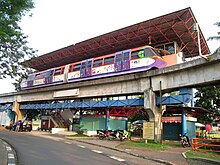Atmospheric railway
This article does not have any sources. (January 2021) |
An atmospheric railway is propelled by differences in atmospheric pressure. Pistons are used there. A piston is connected to the vehicle. At the beginning of railways, different systems were in use in England and in France. All systems were only used for a short time: maintenance cost was high, and there were recurring problems with the connection of the piston (tube) to the vehicle. At first, atmospheric railways were used to go downhill. The locomotives of the times didn't have enough power. That way, it speeds up to 160 kilometres per hour (99 mph) were reached. At the end of the 20th century, the airport of Porto Alegre in Brazil uses an atmospheric railways. There is also a theme park in Indonesia with a 3.2 kilometres (2.0 mi) long circular atmospheric railway.[1]

Reference
change- ↑ "A Successful Atmospheric Railway", The New York Times, 10 November 1852